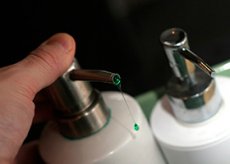New publications
The antibacterial ingredient triclosan has proven to be very dangerous
Last reviewed: 02.07.2025

All iLive content is medically reviewed or fact checked to ensure as much factual accuracy as possible.
We have strict sourcing guidelines and only link to reputable media sites, academic research institutions and, whenever possible, medically peer reviewed studies. Note that the numbers in parentheses ([1], [2], etc.) are clickable links to these studies.
If you feel that any of our content is inaccurate, out-of-date, or otherwise questionable, please select it and press Ctrl + Enter.

The well-known substance triclosan is an antimicrobial and antifungal component present in detergents, cleaning agents, toothpaste, deodorants and household chemical solutions. Triclosan has been used in industry for almost fifty years: initially, this substance was supposed to protect consumers from the negative effects of dirt and microbes.
It is noteworthy that triclosan was first actively added to all kinds of hygiene products. And only then did scientists begin to study the safety of this component, and over time, the results of such studies became increasingly contradictory. For example, the Canadian government initiated a review of antimicrobial ingredients. It described that triclosan in small quantities (such as those present in cosmetics, detergents and toothpaste) does not pose a danger to human health, but is harmful to the environment, as it has a toxic effect on aquatic ecological systems.
Thus, triclosan was included in the top ten basic pollutants that were found in water bodies of the United States. And during a nationwide study of the health of Americans, traces of triclosan were found in the urine of 75% of the people examined.
In the latest study, specialists from the University of Massachusetts tried to determine whether the antimicrobial substance in question is related to the development of inflammatory bowel pathologies. The experiment was conducted on rodents. For 21 days, the animals received a certain dose of triclosan in quantities comparable to those found in human blood.
After just 21 days, the scientists diagnosed the rodents with initial signs of an inflammatory process in the colon.
Triclosan was then administered to animals genetically modified to develop inflammation in the intestines. After three weeks, the rodents showed signs of inflammation and increased growth of malignant cells. One group of mice showed a significant reduction in life expectancy.
Experts suggested that the antimicrobial component is capable of influencing the intestinal microbiome. At the same time, an inflammatory process is triggered. According to the results of the analysis, triclosan reduced the diversity of intestinal microflora in animals.
It should be noted that similar studies involving humans have not yet been conducted. However, scientists are insisting on an urgent additional research project.
Last year, more than two hundred medical professionals in the United States signed a petition calling for the complete elimination of triclosan from household use. The petition stated that the ingredient has both unproven safety and unproven effectiveness.
"Thanks to advertising, many people believe that antimicrobial agents can provide reliable protection against various diseases," explains Professor Barbara Sattler. "However, as practice shows, such agents help no better than ordinary soapy water."
In addition, a year ago, researchers determined that a chemical antimicrobial agent can accumulate in toothbrush bristles, and these accumulations can reach potentially dangerous concentrations.
All the warnings from scientists regarding triclosan are described in the New Atlas publication (https://newatlas.com/triclosan-gut-bacteria-inflammation-cancer/54844/).
